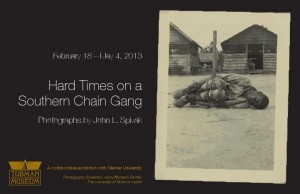
Exhibit exposes Georgia’s human rights indignities
The photos are hard to look at for more than a few seconds. Images of torture on American soil. In one, an inmate is bound by hand and foot to a post and left to swelter in the Georgia heat. The experience of viewing them seems dirty and exploitative, but the uncomfortable feeling pales in comparison to the reality. For the young man in the photograph, this was his reality.
“Hard Times on the Southern Chain Gang” is currently on display at the Tubman African American Museum. The exhibit features photographs taken in 1931 by John L. Spivak, who received credentials from the Georgia Prison Commissioner to visit chain gangs for a report on prison reform. What he documented led to a novel “about the dehumanizing system of sharecropping, chain gains, and peonage in the South.”
David A. Davis, assistant professor of English at Mercer University, curated the exhibition. A specialist in 20th-century Southern literature, he recently re-published Spivak’s novel, “Hard Times on a Southern Chain Gang.”
“I discovered John L. Spivak when researching chain gangs and literature,” Davis said. “He published a novel based on chain gangs in 1932, but I was especially interested in the research he had done for the book… He interview(ed) the state prison commissioner in Atlanta, visited chain gangs, interviewed guards and inmates, and took pictures. I republished his novel last year, retitled ‘Hard Times on the Southern Chain Gang,’ but I thought the pictures were extremely important and that they need(ed) to be seen.”
So Davis worked with the Tubman African American Museum in Macon to coordinate an exhibit of the photos.
“The pictures show life in convict camps in disturbing details. We see inmates living in cages, working on highways and being blatantly tortured. They require us to ask difficult questions about our racial past and human rights. The pictures on display at the Tubman Museum are digital prints of originals archived at the Harry Ransom Humanities Research Center at the University of Texas, Austin.”
Though Spivak published his book, there was now public outcry. Davis explained, “It was overshadowed by Robert Burns’ ‘I am a Fugitive from a Georgia Chain Gang,’ which was published the same year and made into a blockbuster movie, also in the same year, 1932. Burns was a white man from New Jersey sentenced to the chain gang for a petty crime. The story’s it-can-happen-to-you factor fascinated national audiences, much more than Spivak’s expose of black life in the South. So, short answer, no, which makes it that much more disturbing.”
Davis said he hopes that this exhibit will prompt audiences to examine current progress on human rights. “I would like audiences to recognize an often repressed element of our history and to question the progress he have and have not made on human rights.”
Davis will present a gallery talk about the exhibit on Thursday, March 28 from 6-7:30 p.m. at the Tubman African American Museum. The exhibit will be on display through May 4.
Tubman African American Museum: 340 Walnut St., Macon; 478-743-8544; www.tubmanmusem.com
Recent Content
-
Artsarticle ·
-
Artsarticle ·
-
Artsarticle ·

